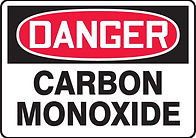top of page

Carbon Monoxide Continued...
SOURCES OF CARBON MONOXIDE
Any machine that burns fuel can produce CO. Many ordinary household appliances and machines may produce CO, including:
-
Non-electrical fuel fired furnaces
-
Gas powered appliances – water heaters, stoves and dryers
-
Fireplaces, wood stoves and charcoal grills
-
Garden appliances – lawnmowers, snow blowers and leaf blowers
-
Automobiles
-
Smoking indoors over a long period of time
These machines can produce CO if they do not have enough fresh air flowing around them. If CO builds up around your family, you can be poisoned, injured or even killed.
DON'T LET IT GET TO YOU
CO, which is odorless, tasteless and invisible, can be found in many places. How can you keep from being affected by it? A little bit of prevention goes a long way.
Prevent CO emergencies by avoiding dangerous activities. Never run your car or other gas powered engines in the house or garage. Even if your garage door is open, dangerous gases including CO will still remain in your garage. Do not use a gas or charcoal grill in enclosed spaces as well.
CALL IN THE PROFESSIONALS
equipment. A blocked or leaking chimney or an undersized vent on a furnace or water heater can lead to CO buildup in your home. If you have a new appliance installed, make sure that the venting system is adequate.
Have your heating system professionally inspected every year. Only a trained expert can make sure that there are no leaks in the heating equipment vents. Have other fuel burning appliances, like your stove and dryer inspected from time to time to be sure that they are receiving enough fresh air.
A BIT OF BACKUP
Prevent a CO emergency by installing CO alarms. CO alarms look like smoke alarms and are also available in combination units that will do both. CO alarms are available at any hardware store or department stores such as Wal-Mart, Fleet Farm or ShopKo.
CO alarms may be battery powered or electric with a plug in. Electric models can be used in any outlet. Battery powered units are useful where outlets are not available. It is wise to have both types of units in your home or to get a unit that is powered by electricity and has a battery backup system.
INSTALLATION
At a minimum, place on CO alarm near all sleeping areas. For the next level of protection, install one alarm on each level of the home. Please some alarms on the ceiling and others can be installed where outlets are available. Do not install CO alarms within 15 feet of cooking or heating areas, or in damp areas, such as bathrooms. This will cause the alarm to give you a false reading.
RESPOND CORRECTLY
If your CO alarm sounds, DO NOT PANIC. First, find out if anyone is feeling sick. Early symptoms of CO exposure are headache, sleepiness, nausea and dizziness. If anyone has these symptoms, leave the house immediately. Use a neighbors phone to dial the Amherst Fire District (DIAL 911), or your responding fire department. If no one feels ill, you probably don't need the fire department. Turn off any fuel burning appliances. Open windows for ventilation and reset the alarm. If the alarm sounds again or you are unable to reset it, have a heating and ventilation expert inspect your home as soon as possible.
IF ANYONE BEGINS TO SHOW SIGNS OF CO, EVACUATE AND DIAL 911.
NEED TO KNOW
These are some simple tips to help you to know all about CO. Every year, 1,500 people die of CO poisoning and 10,000 others need medical attention because of it. CO poisoning is a real threat, one that you cannot see, smell, or taste, but YO
bottom of page
